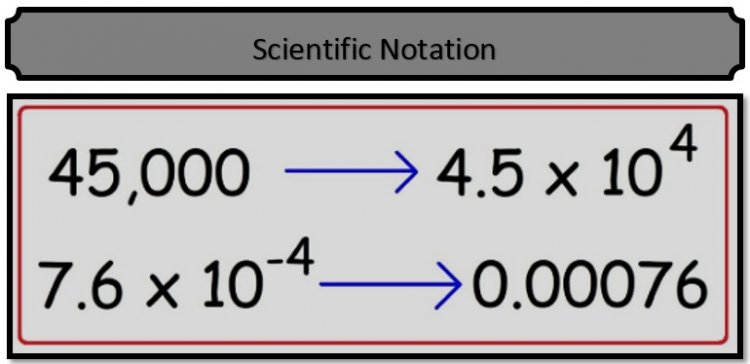Scientific notation
Scientific notation

Scientific notation
Scientific notation is a technique for representing extremely big or extremely small numbers. It is frequently referred to as conventional or exponential notation. It is often used in scientific and mathematical contexts to express numbers in a concise and standardized format.
Defination:
In scientific notation, a number is expressed as the product of two factors: a factor and a power of 10. A factor is a number between 1 and 10 (inclusive), and a power of 10 indicates the size of the number.
The general form of a number in exponential notation is:
a×10^b
The coefficient "a" needs to be less than or equal to 10 as well as greater than or equivalent to 1. The exponent "b" can be positive, negative, or zero.
Example:
3,500,000 = 3.5 x 10^6
In this example, the number 3,500,000 is expressed as 3.5 multiplied by 10 raised to the power of 6. The exponent 6 indicates that the decimal point has been shifted six places to the right to form the original number.
Te speed of light is 299,792,458. In scientific notation, this would be written as 2.99792458 × 10^8 m/s.
In the example above, the decimal part is 2.99792458, which is greater than 1 but less than 10. The power of 10 is 8, which means that the decimal point is shifted 8 places to the right to get the original value of 299,792,458 .
Here are some examples that illustrate scientific notation:
The mass of the Earth is about 5,972,000,000,000,000,000,000 kg. In scientific notation, this can be written as 5.972 × 10^24 kg.
The charge of an electron is about -1.602176634 × 10^-19 coulombs. A negative exponent indicates a very small value.
Avogadro's Number:
Avogadro's number represents the number of atoms or molecules in one mole of a substance and is approximately 6.02214076 x 10^23. The number 6.02214076 is between 1 and 10, and the exponent 23 indicates that the decimal point should be moved 23 places to the right.
Planck's constant:
Planck's constant is a fundamental constant in quantum mechanics and has a value of approximately 6.62607015 x 10^-34 joule-seconds. The number 6.62607015 is between 1 and 10, and the exponent -34 indicates that the decimal point should be moved 34 places to the left.
Application:
Scientific notation provides a concise representation of numbers with many zeros and helps make calculations and equations more manageable. This is especially useful when dealing with very large or very small numbers found in scientific research, astronomy, physics, chemistry, and other fields of science.
Scientific notation is commonly used in science and math to represent very large or very small numbers in a concise, standardized format. It is especially useful in measurements, astronomical distances or microscopic scales, where the numbers can be extremely large or small.
Importance of scientific notation:
Scientific notation is a way of expressing very large or very small numbers in a compact and convenient way. It is an important mathematical tool in science and engineering for several reasons:
Expressing large and small numbers:
Scientific notation allows us to express very large or small numbers concisely. For example, the mass of the Earth is about 5.97 x 10^24 kg and the charge of an electron is about 1.6 x 10^-19 coulomb. These numbers would be cumbersome and difficult to use if they were written in standard decimal notation.
Clarity and Accuracy:
Scientific notation provides a clear and unambiguous representation of numbers. This makes it easier to understand and compare values without counting lots of zeros or decimals. This notation also helps maintain the accuracy of calculations and measurements because significant digits are clearly displayed.
Simplified Calculations:
Scientific notation simplifies arithmetic operations on large or small numbers. When multiplying or dividing, numbers in exponential notation are much easier to work with than long strings of numbers. Using the exponential laws makes calculations more efficient and less prone to error.
Communication and standardization: Scientific notation is widely used in scientific literature, research papers, and technical documentation. Its use ensures consistency and standardization across scientific disciplines and enables scientists from different fields to communicate effectively. It also facilitates data sharing and collaboration among researchers.
Physical and astronomical measurements:
In fields such as physics and astronomy, scientific notation is needed to represent measures and quantities. These disciplines often deal with extremely large distances (such as the distance between galaxies) or small particles (such as the size of an atom). Scientific notation allows scientists to accurately and concisely express these measurements.
Order-of-magnitude representation:
Scientific notation makes it easier to understand and visualize the order of magnitude of a number. Separating the significant digits from the exponent reveals whether the value is in the range of billions, millions, thousands, or fractions of units, which aids in understanding the scale of a given value.
Compact Representation:
Scientific notation allows us to represent multi-digit numbers in a compact and convenient way. It uses a decimal factor multiplied by a power of 10, making it easy to work with and compare numbers of completely different sizes.
Supports significant figures:
Scientific notation is often used when working with measurement data and experimental data, where significant figures (numbers that contribute to the accuracy of a value) are critical. By expressing the values in exponential notation, we can easily determine the number of significant digits and maintain sufficient accuracy in the calculation.
Facilitate communication:
Scientific notation is widely used in scientific research, engineering and other fields to communicate numerical values efficiently. This helps convey information concisely and makes the size of the number easy to understand.
Thus, scientific notation plays a vital role in science and technology by providing a concise and practical way to express large and small numbers, facilitating calculations, providing clarity and precision, promoting standardization, and aiding in the representation of orders of numbers. size.
What's Your Reaction?





















